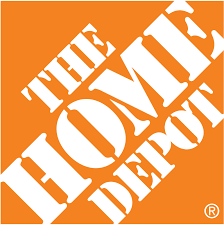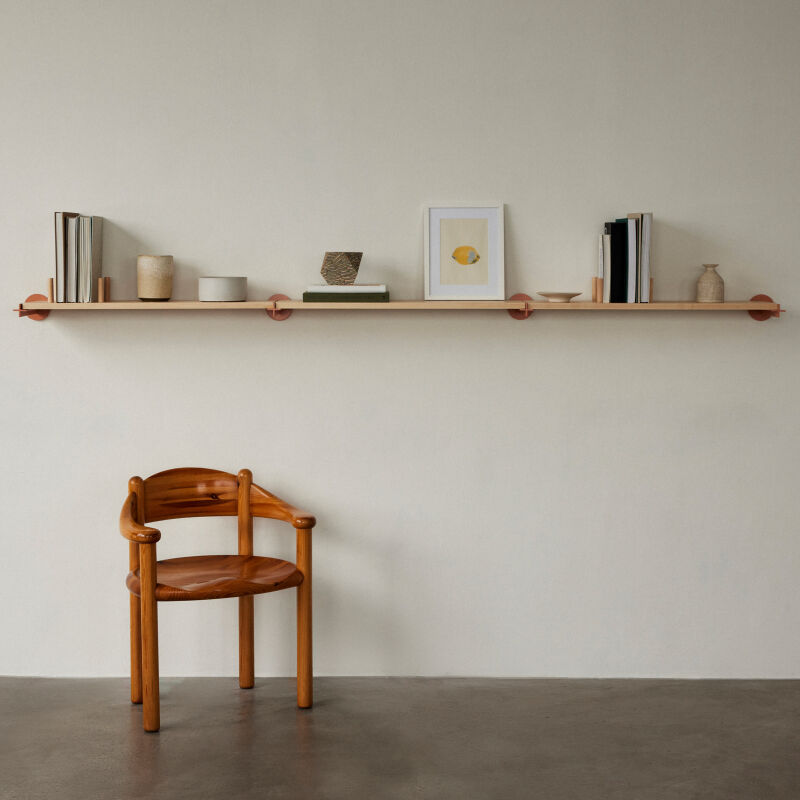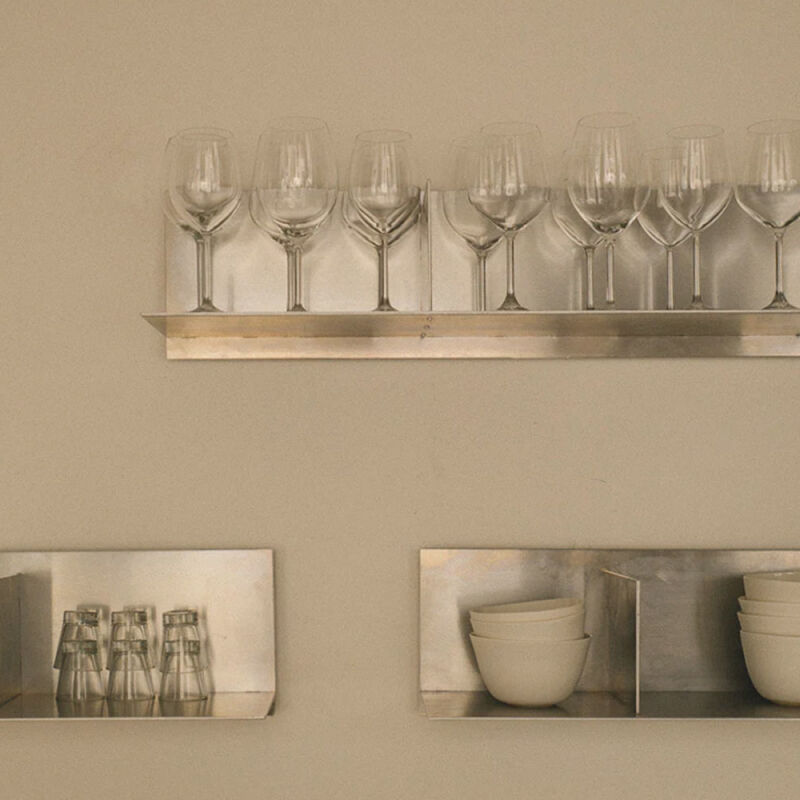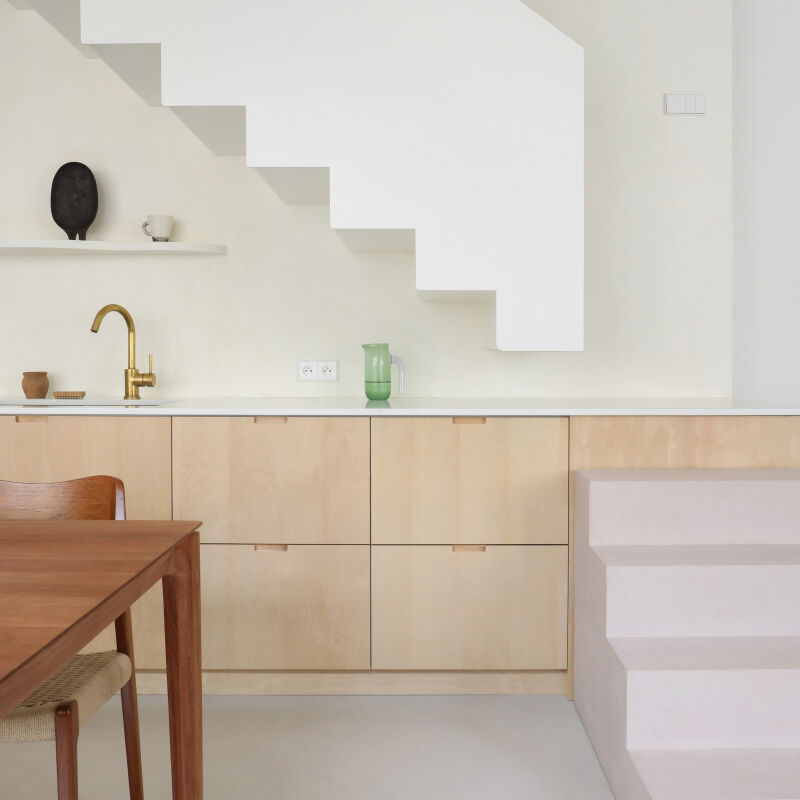What to do with an awkward space under a countertop that’s too shallow for barstools, and has a faux-mahogany surface (visible from my mahogany-free living room) and a particle board underside (as on view)? I’ve known the answer since the day I moved in: make a custom-fitted bookcase to hide both surfaces and add open storage space to boot.
Though I’ve done some woodworking in my day, I was short on time and long on demands, so I partnered with San Francisco cabinetmaker Len Knyper to get the job done. Knowing I wanted to make the bookcase at home with minimal tools, dollars, and time, Knyper walked me through the steps.
Photography by Meredith Swinehart.
Finished Results

Above: My completed bookcase rounds out my living room and fills the empty spot beneath my countertop. It now stores my cookbooks, extra glassware and table linens, and tea light candles and holders. Photography shot with the Canon EOS 70D digital SLR camera, with Dual Pixel AF technology and built-in Wi-Fi.
Materials
- Plywood in quantities to fit your space. I love the look of birch and maple ply, which are virtually indistinguishable and generally comparable in price. A 4 x 8 foot piece of 3/4-inch PureBond Birch FSC plywood is $47.97 at The Home Depot.
- Medium density fiberboard to serve as the backing for your cabinet; 1/4-inch 2 x 4 foot MDF is $6.27 at The Home Depot.
- 2-inch finishing nails to hold your bookcase together. Grip-Rite 2-inch 6D Bright Steel Finish Nails are $3.47 for a 1 lb box at The Home Depot.
- Wood glue for added strength; an 8-ounce bottle of Gorilla Wood Glue is $4.47 at The Home Depot.
- A nail gun, such as the HDX 4-Piece Pneumatic Finishing Kit; $99.88 at The Home Depot.
- A power sander to remove irregularities in the plywood and, if you like, add rounded edges. The Dremel Multi-Max Oscillating Tool Kit is on special for $69 at The Home Depot.
- A hand sander for the final pass with fine-grain sandpaper. A Tempered-Aluminum Base Plate Hand Sander is $8.96 at The Home Depot and 150 Grit Fine Sandpaper Sheets are $3.97 for a pack of three 9 x 11 inch sheets.
- A drill to add holes for shelf-support pegs. I used the Ryobi 18-Volt One+ Lithium-Ion Drill Kit; $79 at The Home Depot.
- Nickel-Plated Steel Shelf Support Pegs; $1.53 for a pack of eight at The Home Depot.
Instructions

Above: Start with enough plywood to make all of the surfaces of your bookcase, excluding the back, and cut to size. (A hardware store or woodworker will trim plywood for you, or you can use a circular saw, like the Skil 13-Amp 7-1/4-in Saw; $53.97 at The Home Depot.)
Use a sheet of 1/4-inch MDF for the back of the shelf; it’s cheaper than plywood. Trim the sheet to fit, making sure to cut only two edges: You’ll want to keep two adjoining factory edges intact; they make a perfectly square corner, so you can rely on that corner to tell you that the rest of your bookcase is square.
Add a little bit of wood glue before nailing the plywood edges together, but forgo the glue when adding the MDF backing; if you nail it well, glue isn’t necessary, and the risk of it oozing onto your bookcase is greater than the risk of the backing falling off.

Above: Use the nail gun to install nails every eight inches or so, wherever plywood meets plywood. If you want, you can create a small toe kick below the bookcase, as I did. The toe kick is not attached to the bookcase; it’s simply a rectangular stand for the cabinet to sit on. Make the toe kick using the same method described here for the bookcase, with four sides plus two or three struts in the middle. (The struts are support beams that run perpendicular to the long edges of the toe kick, parallel to the short edges.)
Above: Once you’ve glued and nailed the plywood and nailed the MDF backing onto your bookcase, it’s time to sand. Plywood will always have some irregularities; start with 80-grit sandpaper on a power sander. I “eased” (or rounded) the edges of my bookcase and shelves; this is optional and can be done with a power sander. Finish the sanding with a hand sander and fine 150-grit sandpaper.
Above: Drill holes for shelf support pegs wherever you want your shelves. (For a typical cabinet with adjustable shelves, you would drill multiple holes at regular intervals, so the shelves are adjustable. I don’t like the look of holes running down the sides, and I knew where I wanted my shelves, so I only created enough holes for the shelves I wanted.)

Above: My fully stocked bookcase, subtley decked out for the holidays. I wanted the bottom row of shelves to have identical dimensions, and the shelves above to vary.

Above: I love the way my grandmother’s German star glassware shines against the light wood.

Above: Copper is too beautiful to hide in a drawer. Here, miniature baking tins for holiday goods.

Above: Am I the only one who thinks cookbooks are, on the whole, an ugly bunch? I used brown kraft paper and red rosin paper to cover mine. A roll of Trimaco Red Rosin Medium Weight Paper is $11.97 and Trimaco Brown Builder’s Paper is $10.97 at The Home Depot.

Above: I dropped some baking twine on a small antler and liked how it looked, so I wrapped it around a few times and called it a Christmas decoration.

Above: A bay and tallow berry wreath is nestled in one of the cubbies, alongside pewter cups and ceramic baking dishes.
Before
Above: Pre-bookcase, I had an awkward empty space under a counter. Lined with faux mahogany, it was peppered with tiny chips and required staining; instead I entirely covered it up–and gained much-needed storage.









Have a Question or Comment About This Post?
Join the conversation